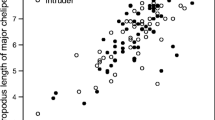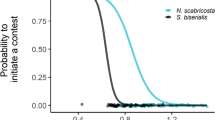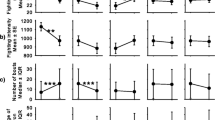Abstract
Agonistic interactions in animals are often settled based on the rules of an assessment strategy. We tested the predictions of evolutionary game theory models (including two models based on self-assessment: (a) the energetic war of attrition model, (b) the cumulative assessment model, and a third model (c) based on mutual assessment model) during contests between males of the Great Himalayan leaf-nosed bat Hipposideros armiger. We also studied the potential proxies of resource holding potential (RHP: body mass and forearm length) and their relationship to contest duration and the level of escalation. Overall, heavier males won more contests than lighter males, and they had an advantage in physical fights. In physical contests, the contest duration was positively correlated with the body mass of the loser but not the body mass of the winner. These results supported the prediction that males make decisions based on their own RHP (self-assessment: the energetic war of attrition model) rather than on RHP of their opponent (mutual assessment). Contest duration was not related to the forearm length of the winner or the loser. No relationship between body size (i.e., body mass and forearm length) and contest duration was observed for non-physical contests. This did not support any of the predictions applying to the energetic war of attrition model, the cumulative assessment model, and the mutual assessment model, indicating that no assessment occurred during non-physical contests. This study provides the first empirical evidence that bats make decisions based on their own RHP during agonistic interactions.
Significance statement
This study provides empirical evidence supporting the hypothesis that during physical contests bats make decisions based on estimates of their own ability (self-assessment) rather than on a process of mutual assessment. This finding will facilitate comparative studies of fighting strategy across bat species.





Similar content being viewed by others
References
Archer J (1998) The behavioural biology of aggression. Cambridge University Press, Cambridge
Arnott G, Elwood RW (2009) Assessment of fighting ability in animal contests. Anim Behav 77:991–1004. https://doi.org/10.1016/j.anbehav.2009.02.010
Bakker TCM, Feuth-de Bruijn E, Sevenster P (1989) Asymmetrical effects of prior winning and losing on dominance in sticklebacks (Gasterosteus aculeatus). Ethology 82:224–229. https://doi.org/10.1111/j.1439-0310.1989.tb00502.x
Barki A, Harpaz S, Karplus I (1997) Contradictory asymmetries in body size and weapon size, and assessment in fighting male prawns, Macrobrachium rosenbergii. Aggressive Behav 23:81–91. https://doi.org/10.1002/(SICI)1098-2337(1997)23:2<81::AID-AB1>3.0.CO;2-W
Bastian A, Schmidt S (2008) Affect cues in vocalizations of the bat, Megaderma lyra, during agonistic interactions. J Acoust Soc Am 124:598–608. https://doi.org/10.1121/1.2924123
Bates P, Bumrungsri S, Francis C, Csorba G (2008) Hipposideros armiger. IUCN red list of threatened species, version 2017.3, http://www.iucnredlist.org
Benítez ME, Pappano DJ, Beehner JC, Bergman TJ (2017) Evidence for mutual assessment in a wild primate. Sci Rep 7:2952. https://doi.org/10.1038/s41598-017-02903-w
Bradbury J, Emmons L (1974) Social organization of some Trinidad bats I. Emballonuridae. Z Tierpsychol 36:137–183
Bradbury JW, Vehrencamp SL (2011) Conflict resolution. In: Bradbury JW, Vehrencamp SL (eds) Principles of animal communication, 2nd edn. Sinauer Associates, Sunderland, MA, pp 421–465
Bridge AP, Elwood RW, Dick JTA (2000) Imperfect assessment and limited information preclude optimal strategies in male–male fights in the orb-weaving spider Metellina mengei. Proc R Soc Lond B 267:273–279
Briffa M (2008) Decisions during fights in the house cricket, Acheta domesticus: mutual or self assessment of energy, weapons and size? Anim Behav 75:1053–1062. https://doi.org/10.1016/j.anbehav.2007.08.016
Briffa M (2015) Animal signaling: integrating analysis of functions and mechanisms. In: Irschick DJ, Briffa M, Podos J (eds) Animal signaling and function: an integrative approach. John Wiley & Sons, Hoboken, NJ, pp 141–173
Briffa M, Elwood RW (2004) Use of energy reserves in fighting hermit crabs. Proc R Soc Lond B 271:373–379. https://doi.org/10.1098/rspb.2003.2633
Cheng HC, Lee LL (2002) Postnatal growth, age estimation, and sexual maturity in the formosan leaf-nosed bat (Hipposideros terasensis). J Mammal 83:785–793
Clement MJ, Kanwal JS (2012) Simple syllabic calls accompany discrete behavior patterns in captive Pteronotus parnellii: an illustration of the motivation-structure hypothesis. Sci World J 2012:128695. https://doi.org/10.1100/2012/128695
Clement MJ, Dietz N, Gupta P, Kanwal JS (2006) Audiovocal communication and social behavior in mustached bats. In: Kanwal JS, Ehret G (eds) Behavior and neurodynamics for auditory communication. Cambridge University Press, Cambridge, pp 57–84
deCarvalho TN, Watson PJ, Field SA (2004) Costs increase as ritualized fighting progresses within and between phases in the sierra dome spider, Neriene litigiosa. Anim Behav 68:473–482. https://doi.org/10.1016/j.anbehav.2003.08.033
Draud M, Lynch PAE (2002) Asymmetric contests for breeding sites between monogamous pairs of convict cichlids (Archocentrus nigrofasciatum, Cichlidae) pair experience pays. Behaviour 139:861–873
Elwood RW, Arnott G (2012) Understanding how animals fight with Lloyd Morgan's canon. Anim Behav 84:1095–1102. https://doi.org/10.1016/j.anbehav.2012.08.035
Elwood RW, Arnott G (2013) Assessments in contests are frequently assumed to be complex when simple explanations will suffice. Anim Behav 86:e8–e12. https://doi.org/10.1016/j.anbehav.2013.09.006
Enquist M, Leimar O (1983) Evolution of fighting behaviour decision rules and assessment of relative strength. J Theor Biol 102:387–410. https://doi.org/10.1016/0022-5193(83)90376-4
Enquist M, Leimar O (1990) The evolution of fatal fighting. Anim Behav 39:1–9. https://doi.org/10.1016/S0003-3472(05)80721-3
Enquist M, Leimar O, Ljungberg T, Mallner Y, Segerdahl N (1990) A test of the sequential assessment game fighting in the cichlid fish Nannacara anomala. Anim Behav 40:1–14. https://doi.org/10.1016/S0003-3472(05)80660-8
Fernandez AA, Fasel N, Knörnschild M, Richner H (2014) When bats are boxing: aggressive behaviour and communication in male Seba's short-tailed fruit bat. Anim Behav 98:149–156. https://doi.org/10.1016/j.anbehav.2014.10.011
Galeotti P, Saino N, Sacchi R, Møller AP (1997) Song correlates with social context, testosterone and body condition in male barn swallows. Anim Behav 53:687–700. https://doi.org/10.1006/anbe.1996.0304
Green PA, Patek SN (2018) Mutual assessment during ritualized fighting in mantis shrimp (Stomatopoda). Proc R Soc B 285:20172542. https://doi.org/10.1098/rspb.2017.2542
Hsu Y, Wolf LL (1999) The winner and loser effect: integrating multiple experiences. Anim Behav 57:903–910. https://doi.org/10.1006/anbe.1998.1049
Hsu Y, Lee S-P, Chen M-H, Yang S-Y, Cheng K-C (2008) Switching assessment strategy during a contest: fighting in killifish Kryptolebias marmoratus. Anim Behav 75:1641–1649. https://doi.org/10.1016/j.anbehav.2007.10.017
Jennings DJ, Gammell MP, Carlin CM, Hayden TJ (2004) Effect of body weight, antler length, resource value and experience on fight duration and intensity in fallow deer. Anim Behav 68:213–221. https://doi.org/10.1016/j.anbehav.2003.11.005
Jiang T, Huang X, Wu H, Feng J (2017) Size and quality information in acoustic signals of Rhinolophus ferrumequinum in distress situations. Physiol Behav 173:252–257. https://doi.org/10.1016/j.physbeh.2017.02.025
Kelly CD (2006) Fighting for harems: assessment strategies during male–male contests in the sexually dimorphic Wellington tree weta. Anim Behav 72:727–736. https://doi.org/10.1016/j.anbehav.2006.02.007
Kemp DJ, Alcock J, Allen GR (2006) Sequential size assessment and multicomponent decision rules mediate aerial wasp contests. Anim Behav 71:279–287. https://doi.org/10.1016/j.anbehav.2005.03.038
Kunz TH, Weise CD (2009) Methods and devices for marking bats. In: Kunz TH, Parsons S (eds) Ecological and behavioral methods for the study of bats, 2nd edn. Johns Hopkins University Press, Baltimore, MD, pp 36–56
Logue DM, Abiola IO, Rains D, Bailey NW, Zuk M, Cade WH (2010) Does signalling mitigate the cost of agonistic interactions? A test in a cricket that has lost its song. Proc R Soc Lond B 277:2571–2575. https://doi.org/10.1098/rspb.2010.0421
Luo B, Lu G, Chen K, Guo D, Huang X, Liu Y, Feng J (2017) Social calls honestly signal female competitive ability in Asian particoloured bats. Anim Behav 127:101–108. https://doi.org/10.1016/j.anbehav.2017.03.012
Matos RJ, Schlupp I (2005) Performing in front of an audience: signalers and the social environment. In: McGregor PK (ed) Animal communication networks. Cambrige University Press, Cambridge, pp 63–83
Maynard Smith J (1982) Evolution and the theory of games. Cambridge University Press, Cambridge
McWilliam AN (1988) Social organisation of the bat Tadarida (Chaerephon) pumila, (Chiroptera: Molossidae) in Ghana, West Africa. Ethology 77:115–124. https://doi.org/10.1111/j.1439-0310.1988.tb00197.x
Morrell LJ, Backwell PRY, Metcalfe NB (2005) Fighting in fiddler crabs Uca mjoebergi: what determines duration? Anim Behav 70:653–662. https://doi.org/10.1016/j.anbehav.2004.11.014
Parker GA (1974) Assessment strategy and the evolution of fighting behaviour. J Theor Biol 47:223–243. https://doi.org/10.1016/0022-5193(74)90111-8
Payne RJH (1998) Gradually escalating fights and displays: the cumulative assessment model. Anim Behav 56:651–662. https://doi.org/10.1006/anbe.1998.0835
Payne RJH, Pagel M (1996) Escalation and time costs in displays of endurance. J Theor Biol 183:185–193. https://doi.org/10.1006/jtbi.1996.0212
Payne RJH, Pagel M (1997) Why do animals repeat displays. Anim Behav 54:109–119. https://doi.org/10.1006/anbe.1996.0391
Porter FL (1979) Social behavior in the leaf-nosed bat, Carollia perspicillata. I. Social organization. Z Tierpsychol 49:406–417. https://doi.org/10.1111/j.1439-0310.1979.tb00301.x
Pratt AE, McLain DK, Lathrop GR (2003) The assessment game in sand fiddler crab contests for breeding burrows. Anim Behav 65:945–955. https://doi.org/10.1006/anbe.2003.2152
Prenter J, Elwood RW, Taylor PW (2006) Self-assessment by males during energetically costly contests over precopula females in amphipods. Anim Behav 72:861–868. https://doi.org/10.1016/j.anbehav.2006.01.023
Reichert MS, Gerhardt HC (2011) The role of body size on the outcome, escalation and duration of contests in the grey treefrog, Hyla versicolor. Anim Behav 82:1357–1366. https://doi.org/10.1016/j.anbehav.2011.09.019
Reichert MS, Quinn JL (2017) Cognition in contests: mechanisms, ecology, and evolution. Trends Ecol Evol 32:773–785. https://doi.org/10.1016/j.tree.2017.07.003
Rudin FS, Briffa M (2011) The logical polyp: assessments and decisions during contests in the beadlet anemone Actinia equina. Behav Ecol 22:1278–1285. https://doi.org/10.1093/beheco/arr125
Schuett GW (1997) Body size and agonistic experience affect dominance and mating success in male copperheads. Anim Behav 54:213–224. https://doi.org/10.1006/anbe.1996.0417
Silk JB, Kaldor E, Boyd R (2000) Cheap talk when interests conflict. Anim Behav 59:423–432. https://doi.org/10.1006/anbe.1999.1312
Sneddon LU, Huntingford FA, Taylor AC (1997) Weapon size versus body size as a predictor of winning in fights between shore crabs, Carcinus maenas (L.). Behav Ecol Sociobiol 41:237–242. https://doi.org/10.1007/s002650050384
Stamps JA, Krishnan VV (1994) Territory acquisition in lizards: I. First encounters. Anim Behav 47:1375–1385. https://doi.org/10.1006/anbe.1994.1185
Sterbing-D'Angelo S, Chadha M, Chen C, Falk B, Xian W, Barcelo J, Zook JM, Moss CF (2011) Bat wing sensors support flight control. Proc Natl Acad Sci U S A 108:11291–11296. https://doi.org/10.1073/pnas.1018740108
Stuart-Fox D (2006) Testing game theory models: fighting ability and decision rules in chameleon contests. Proc R Soc Lond B 273:1555–1561. https://doi.org/10.1098/rspb.2006.3468
Stuart-Fox D, Johnston G (2005) Experience overrides colour in lizard contests. Behaviour 142:329–350. https://doi.org/10.1163/1568539053778265
Taylor PW, Elwood RW (2003) The mismeasure of animal contests. Anim Behav 65:1195–1202. https://doi.org/10.1006/anbe.2003.2169
Taylor PW, Hasson O, Clark DL (2001) Initiation and resolution of jumping spider contests: roles for size, proximity, and early detection of rivals. Behav Ecol Sociobiol 50:403–413. https://doi.org/10.1007/s002650100390
Wells MS (1988) Effects of body size and resource value on fighting behaviour in a jumping spider. Anim Behav 36:321–326. https://doi.org/10.1016/S0003-3472(88)80001-0
Williams CF (1986) Social organization of the bat, Carollia perspicillata (Chiroptera: Phyllostomidae). Ethology 71:265–282. https://doi.org/10.1111/j.1439-0310.1986.tb00591.x
Yang (2011) Mating system and kinship of the Formasan leaf-nosed bat, Hipposideros armiger erasensis (Chiroptera, Hippsideridae). Dissertation, National Chung Hsing University
Zhao X, Jiang T, Gu H, Liu H, Sun C, Liu Y, Feng J (2018) Are aggressive vocalizations the honest signals of body size and quality in female Asian particoloured bats? Behav Ecol Sociobiol 72(96). https://doi.org/10.1007/s00265-018-2510-x
Zucker N, Murray L (1996) Determinants of dominance in the tree lizard Urosaurus ornatus: the relative importance of mass, previous experience and coloration. Ethology 102:812–825. https://doi.org/10.1111/j.1439-0310.1996.tb01203.x
Funding
This research was supported by the National Natural Science Foundation of China (grant nos. 31872680 and 31670390).
Author information
Authors and Affiliations
Corresponding authors
Ethics declarations
Conflict of interest
The authors declare that they have no competing interests.
Ethical approval
Bats were captured by mist nets. Then, they were placed individually in cloth bags and transported to housing in temporary field experimental stations near the bat roosts. No bat suffered any obvious effects from the process of capture, transport, and experiment. No visible physical injuries were observed, although some contests involved physical contact. We removed the aluminum alloy bands before the bats were release. All of the captured bats were released in good health at their original site of capture after the completion of the experiment. Experimental procedures were in compliance with the National Natural Science Foundation of China for experiments involving vertebrate animals and were approved by Northeast Animal Research Authority in Northeast Normal University, China (approval number: NENU-W-2017-101).
Data availability
The datasets analyzed during the current study are available from the corresponding author upon request.
Additional information
Communicated by M. Knörnschild
Publisher’s note
Springer Nature remains neutral with regard to jurisdictional claims in published maps and institutional affiliations.
Electronic supplementary material
ESM 1
(DOCX 1.23 MB)
Rights and permissions
About this article
Cite this article
Sun, C., Zhang, C., Gu, H. et al. Self-assessment strategy during contest decisions between male Great Himalayan leaf-nosed bats. Behav Ecol Sociobiol 73, 45 (2019). https://doi.org/10.1007/s00265-019-2657-0
Received:
Revised:
Accepted:
Published:
DOI: https://doi.org/10.1007/s00265-019-2657-0




